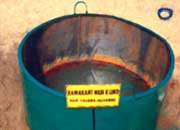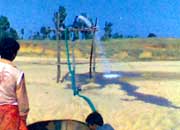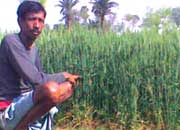“More than 90% agricultural land in Jharkhand is monocropped. Unpredictable rainfall and drought conditions affect the food security and overall livelihood of farm families. Design and installation of Ramakant Nadi Kund may help farmers in growing rabi crops thereby increasing cropping intensity”
Name of Device: Ramakant Nadi Kund
 The state of Jharkhand receives plenty of rain water (annual average rainfall >1300 mm) during monsoon months. Inspite of good rainfall, the state is having only 10 per cent cultivable area under irrigation. The majority of farm families are practicing rainfed monocropped agriculture in vast area due to non availability of irrigation water during rabi (winter) and zaid (summer) seasons. Only few farm families are growing rabi crops by using flowing water in small perennial rivers, creeks, ponds and wells. A number of rivers have been originated in this state with wide catchment area. During rainy season the volume of water flow in these rivers is huge in amount with fast current, but the water recedes quickly after the termination of rain and the river bed full of sand becomes dry.
The state of Jharkhand receives plenty of rain water (annual average rainfall >1300 mm) during monsoon months. Inspite of good rainfall, the state is having only 10 per cent cultivable area under irrigation. The majority of farm families are practicing rainfed monocropped agriculture in vast area due to non availability of irrigation water during rabi (winter) and zaid (summer) seasons. Only few farm families are growing rabi crops by using flowing water in small perennial rivers, creeks, ponds and wells. A number of rivers have been originated in this state with wide catchment area. During rainy season the volume of water flow in these rivers is huge in amount with fast current, but the water recedes quickly after the termination of rain and the river bed full of sand becomes dry.
In the NAIP adopted villages in Jamtara and Dumka districts, small rivers (Joria) and creeks are also flowing with full of water during rainy season, but the water flow reduces to a great extent during dry months. The water flow in the relatively larger rivers like Mayurakshi and Bhurbhuri flowing in the Jama block of Dumka district, also become thinner but these rivers are having wide river bed with full of sand. After termination of rain, the water flow below sand beds. The farm families residing in the villages, situated on the bank of these rivers, lift water with the help of diesel/electric operated pumps by making small ditches and irrigate rabi crops grown in small area. The small ditches made in river bed usually get choked with in a short period of time due to sand sliding during operation. The farmers spend lot of time in cleaning the ditches during pump operation.
Considering availability of sufficient water under the sand bed, wastage of farmers' time in maintaining the ditch and eagerness of farmers in increasing area under rabi cultivation, the suggestion was sought from practicing farmers to overcome the problems arised in maintaining the ditches use for lift irrigation. With farmer participation it was decided that the empty engine oil drum should be used for developing kund (water tank) in the river. The idea was to make a perforated cylinder by removing both the upper and lower lids and make drill small pores in the body of drum. Then this drum will be inserted in the sand bed by removing the sand inside the drum manually. Removal of sand from inside of the drum was not feasible manually because of the small diameter of the drum. It was further thought that kund should be made by joining two engine oil drums but the cost involved was little high. After exploring the Dumka market, it was finally decided that the kund should be developed using iron sheet and iron bar by joining the two ends of iron sheet with vertical and horizontal iron bar enforcement.
Materials and Methods
The materials used in fabrication of " Ramakant Nadi Kund" are given in table 1
Table 1. Details of fabrication of Ramakant Nadi Kund
| S. No. | Description | Specification |
| 1 | Alloy used for fabrication | Iron sheet |
| 2 | Thickness of sheet | 20 gage |
| 3 | Width of sheet | 128.75 cm |
| 4 | Weight | 24 kg |
| 5 | Diameter of Kund | 112.5 cm |
| 6 | Depth of Kund | 128.75 cm |
| 7 | Number of vertical bars for support | 4 |
| 8 | Number of horizontal rings for support | 4 |
| 9 | Number of holes made in the body of Kund | 500 minimum |
| 10 | Diameter of the holes | 6 mm |
| 11 | Depth upto which holes were made (from lower side) | 90 cm |
| 12 | Methods used for making holes | Welding flames |
| 13 | Distance between hole and hole | 10 cm (aaprox) |
Method of fabrication
 Both end of iron sheet was joined by riveting using iron nails. Four vertical and four horizontal bars were fixed inside the Kund by iron nails . Enforcement with horizontal and vertical bars were given to support and save the round shaped Kund from distortion due to outside pressure created by sand during operation of the pump.
Both end of iron sheet was joined by riveting using iron nails. Four vertical and four horizontal bars were fixed inside the Kund by iron nails . Enforcement with horizontal and vertical bars were given to support and save the round shaped Kund from distortion due to outside pressure created by sand during operation of the pump.
Installation of Kund in river bed
 The diameter of Kund was fixed in such a manner so that a person can operate from inside the Kund during installation. During installation of the Kund, three persons were involved to push the Kund inside the sand bed of river. One person was removing the sand using steel bucket from inside the Kund and other two persons were standing outside of the Kund to facilitate the removal of sand from the Kund as well as penetration of Kundm the river bed . The Kund was installed up to 1.0 meter inside the river bed. Further penetration of Kund is not feasible because of fast inflow of water inside the Kund from river bed. The whole process for installation of Ramakant Nadi Kund involves about 2.5 man days.
The diameter of Kund was fixed in such a manner so that a person can operate from inside the Kund during installation. During installation of the Kund, three persons were involved to push the Kund inside the sand bed of river. One person was removing the sand using steel bucket from inside the Kund and other two persons were standing outside of the Kund to facilitate the removal of sand from the Kund as well as penetration of Kundm the river bed . The Kund was installed up to 1.0 meter inside the river bed. Further penetration of Kund is not feasible because of fast inflow of water inside the Kund from river bed. The whole process for installation of Ramakant Nadi Kund involves about 2.5 man days.
Operation
Lifting of water from dry river bed requires following components
- Ramakant Nadi Kund
- Suction pipe with valve
- 2 HP Pump (Diesel or electricity operated)
- Delivery pipes
- Stand made of locally available indigenous materials (locally known as Machan)
With these inputs, the Ramakant Nadi Kund was installed in river Mayurakshi in vill. Gajhanda, block Jama, district Dumka, Jharkhand with farmers' participation. The steps of installation of Ramakant Nadi Kund, dipping valve of suction pipe in the water available in the Kund, connection of suction pipe with motor pump fixed on Machan .




Observation
With regular electricity supply, the pump was operated from 3 PM on 25.2.2010 to 8 AM on 26.2.2010 for irrigation of wheat crop, sown on the bank of river Mayurakshi. The area of wheat grown plot irrigated through pump was 2400 m2. Even with the continuous operation of pump, the water depth in Ramakant Nadi Kund was maintained upto >75 cm with replenishment of water from river bed (Farmer Mr. Suresh Chaudhary's view).
Advantages
Conceptualization and implementation of Ramakant Nadi Kund has saved the man days, money, time and misery faced by the farm families in cultivation of rabi and zaid crops. The regular availability of water in Kund will help in increasing the area under sequence crop after rice harvest. The effectivity of Ramakant Nadi Kund is given in table 2.
Table 2. Details of effectivity of Ramakant Nadi Kund in village Gajhanda, Jama, Dumka, Jharkhand
| S.No. | Process | Pit in the river bed | RamakantNadi Kund |
| 1 | Digging of pit for water storage/fixing of Kund in river bed, saving by using Ramakant Nadi Kund | 6 labourers work 5 hrs for one irrigation = 3.75 man days | 5 labourers work 4hrs for installation of Kund = 2.5 man days |
| 2 | Cost of bamboo basket used to put suction pipe valve during lifting of irrigation water | Rs. 30 per season | Nil |
| 3 | Maintaining of pit during operation of pump for irrigation (man days) to remove sands falling inside the pit | 2 person per day | Nil |
| 4 | Minimum number of days require per irrigation per ha, if pump operates 8 hrs per day | 4 | 4 |
| 5 | Man days required per irrigation/ha | 8 | Nil |
| 6 | Minimum number of irrigation needed for wheat cultivation | 5 | 5 |
| 7 | Total man days for maintaining pits during cultivation of wheat | 8x5 = 40 | Nil |
| 8 | Minimum cost (Rs.) involves in digging & maintaining pit during pump operation @ Rs. 100/man day | (Col l+5)xcol 6) x 100 = (3.75+8)x(5) x 100 = Rs. 5,875 | Rs. 250 |
| 9 | Cost involves in fabricating Ramakant Nadi Kund | Nil | Rs. 2800 |
| 10 | Life Span | For one irrigation only | 3 years |
| 11 | Maintenance cost of Ramakant Nadi Kund | Rs. 500 for 3 yrs (up keeping and painitng) |
Saving by using Ramakant Nadi Kund in 3 years = (Column 8 + column 2) x year - (Column 8+9+11) = Rs. (5,875 + 30) x (3) - (250+2,800+500) = Rs. 17,715 - 3,550 = Rs. 14,165
Demand

Other farmers are also demanding Ramakant Nadi Kund. If provided, it will help in increasing the area under Rabi and laid season crops. This process will lead to increased cropping intensity, more on-farm employment, more income of farm families and no or low male out migration from villages.
(Source: Dr. Ramakant Singh, CRURRS (CRRI) Hazaribag - 825 301 Jharkhand)







फेसबुक पर लाइक करें
यूट्यूब पर सदस्यता लें
X पर फॉलो करना X
इंस्टाग्राम पर लाइक करें